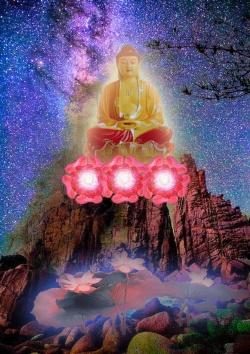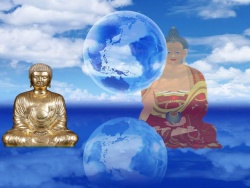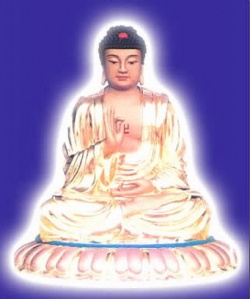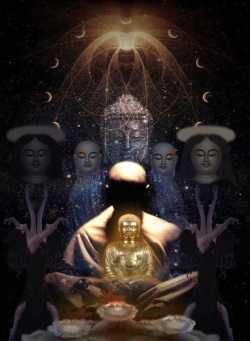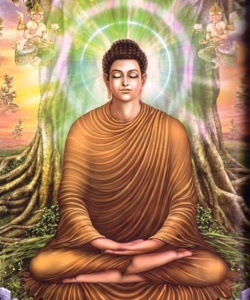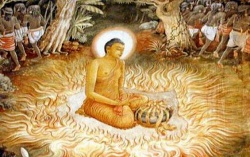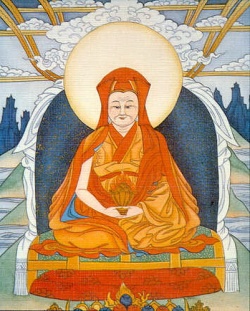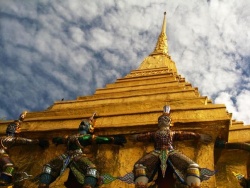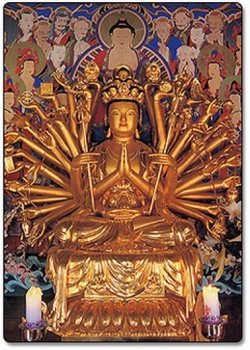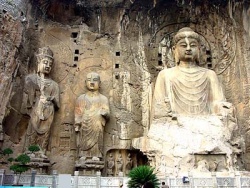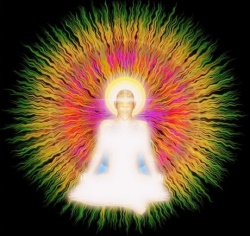A Survey of the Doctrines of the Abhidharma Schools
CONTENTS
Preface v
Abbreviations x
Chapter 1 Abhidharma - Its Origin, Meaning and Function 1
1.1. Origin of the abhidharma 1
1.2. Definitions of abhidharma 9
1 .3. The soteriological function of the abhidharma 13
Chapter 2 The Abhidharmika - Standpoint, Scope and Methodology 18
2. 1 . Fundamental standpoint of the Abhidharmikas 1 8
2.2. Arguments for abhidharma being buddha-vacana 20
2.3. Scope of study of the Abhidharmikas 21
2.4. Abhidharmika methodology for dharma-pravicaya 30
Chapter 3 The Sarvastivada School and Its Notion of the Real 62
3.1. History of the Sarvastivada 62
3.2. Sarvastivada vs. Vibhajyavada 68
3.3. Proof of the thesis of sarvastitva in the VKS, MVS and AKB 70
3.4. Sautrantika critique of the epistemological argument 74
3.5. Notion of the real/existent 76
3.6. The various components of the Sarvastivada school 86
Chapter 4 The Abhidharma Treatises of the Sarvastivada 98
4.1. Seven canonical treatises 98
4.2. Development of the Sarvastivada manuals 127
Chapter 5 Sarvastitva and Temporality 144
5.1. The big debate 144
5.2. Time and temporality 145
5.3. The four main theories of the Sarvastivada 147
5.4. Comments on the four theories and Frauwallner's observations 149
5.5. The Vaibhasika theory of karitra 157
5.6. Samghabhadra's theory — an innovation? 165
5.7. Bhava, svabhava and the dharma 169
Contents
Chapter 6 Theory of Causality I: The Six Causes 181
6.1. The 6 hetu-s, 4 pratyaya-s and 5 phala-s — their correlation 181
6.2. Special importance of the doctrine of causality for the Sarvastivada 183
6.3. Definitions of the six causes 189
6.4. Samghabhadra's defense of simultaneous causation 201
6.5. Explanations in the Yogacara system 203
6.6. Summary of the notion of the co-existent cause given in
the various sources 205
6.7. Doctrinal importance of the co-existent cause for the Sarvastivada 207
Chapter 7 Theory of Causality II
The Four Conditions and the Five Fruits 217
7.1. Doctrine of the four conditions (pratyaya) 217
7.2. Differences between a cause and a condition 227
7.3. Five fruits (phala) 229
7.4. The 'grasping' and 'giving' of a fruit 237
Chapter 8 The Category of Matter (rupa) 242
8.1. General nature and definition of rupa 242
8.2. Primary and derived matter 249
8.3. 'Atomic' theory 259
Chapter 9 The Categories of Thought and
Thought-concomitants (citta-caitta) 273
9.1. Definitions of citta, manas and vijnana 273
9.2. Thought-concomitants (caitta/caitasika) 275
9.3. Development of the theory of caitasika 276
9.4. Sarvastivada doctrine of conjunction (samprayoga) 289
9.5. Darstantika and Sautrantika Doctrine of successive arising 290
9.6. Difference in functionality between citta and caitta-s 293
9.7. Difference between the first five and the sixth consciousnesses 296
9.8. Original nature of thought 299
Chapter 10 Theories of Knowledge 310
10.1. Sarvastivada realism: From epistemology to ontology 311
10.2. Various modes of operation of prajna 317
10.3. Reflexive knowledge and omniscience (sarvajna) 326
10.4. Prajna of the Buddha and the two yana-s 329
10.5. Instrument of perception 336
10.6. Important Sarvastivada thought-concomitants involved in discriminative cognition 343
10.7. Ontological status of the objects of knowledge 345
10.8. Direct perception, dkdra, sdkara-vijfianavada, nirdkdra-jndnavdda and the Sarvastivada 348
Chapter 11 The Category of the Conditionings Disjoined from Thought
(citta-viprayukta-samskara) 371
11.1. Doctrinal evolution of the category 371
11.2. Definition of citta-viprayukta-samskara in later texts 377
11.3. Classic list in the AKB 379
Chapter 12 Defilements 418
12.1. The goal of spiritual praxis and the abandonment of defilement 419
12.2. Klesa and anusaya as the generic terms for defilement 423
12.3. Other doctrinal terms denoting defilements 425
12.4. Defilements as the root of existence 430
12.5. Abhidharmika investigation of defilements 432
12.6. Classification of defilements 435
12.7. Relationship between defilements and the mind 441
12.8. Operation of the defilements 445
12.9. Abandonment of defilements 450
12.10. Traces (vdsand) of the defilements and distinction between
the wisdom of a Buddha and of an arhat 464
Chapter 13 The Doctrine of Karma 480
13.1. Meaning and general nature of karma 480
13.2. Classification of karma 487
13.3. Informative (vijnapti) and non-informative (avijiiapti) karma 489
1 3 .4. Definition and intrinsic nature of informative and non-informative karma 490
13.5. Non-information as restraint, non-restraint and neither-restraint-nor-non-restraint 499
13.6. Paths of karma (karma-patha) 504
13.7. Rationale for the doctrine of non-informative karma 506
13.8. Role of the non-informative in the process of karmic retribution 509
Chapter 14 Karma and the Nature of its Retribution 536
14. 1 . Karmic retribution as a middle-way doctrine 536
14.2. Six causes affecting the gravity of a karma 537
14.3. Determinate and indeterminate karma 539
14.4. A karma that has been done, and one that has been accumulated 542
14.5. Projecting and completing karma-s 547
14.6. Karma in terms of pratitya-samutpada 549
Contents
14.7. Past karma of the arhat-s and the Buddha 554
14.8. Man's karma and his environment, and collective karma 557
Chapter 15 The Path of Spiritual Progress 564
15.1. Doctrine of gradual enlightenment 564
15.2. Preliminaries for the preparatory stage 567
15.3. Different stages of the path 571
1 5.4. Direct comprehension (abhisamaya), path of insight (darsana-marga) and stream entry (srotadpatti) 586
15.5. Non-retrogressibility of stream-entry 597
15.6. Path of cultivation (bhavana-marga) 598
15.7. Attainment of the four fruits of the spiritual life 600
15.8. Out-of-sequence attainments 602
15.9. Retrogressibility of an arhat 603
Chapter 16 The Unconditioned (asamskrta) Dharma-s 613
16.1. Three unconditioned dharma-s of the Sarvastivada 6 1 3
16.2. Cessation through discrimination 617
16.3. Cessation independent of discrimination 633
1. Abhidharma
Its Origin, Meaning and Function
1.1. Origin of the abhidharma
1.1.1. Origin according to tradition
1.1.2. Historical origin
1.2. Definitions of abhidharma
1.3. The soteriological function of the abhidharma
1.1. Origin of the abhidharma 1.1.1. Origin according to tradition
Traditionally, the abhidharma-pitaka is given as the last of the tripitaka-s whose order is: vinaya, sutra, abhidharma — or sutra, vinaya, abhidharma in the northern tradition.
This very probably reflects the historical fact that the abhidharma texts were evolved and compiled as a pitaka later than the other two.
This same fact is also discernible in the ancient triple designations given to the specialists of the Buddhist Canon — vinaya-dhara, sutra-dhara, matrka-dhara.
Significantly, the third term in the list has, instead of abhidharma, the term matrka (Pali: matikd), meaning a matrix in the form of a list summarily enumerating topics to be elaborated upon.
This suggests that at the earlier stage, the study of these mdtrka-s had served as a major basis for the development of the abhidharma-pitaka. (See below).
It is possible that most of the so-called Hinayana schools in India possessed their own sets of tripitaka. Unfortunately, most of these tripitaka texts are no longer extant.
As far as the canonical abhidharma texts are concerned, we are now in possession of only two complete sets: the seven texts of the Theravada preserved in Pali, and the seven Sarvastivada texts in Chinese translation.
Of the latter, however, the Prajhapti-sastra (PjS) is only a partial translation; a fuller version is preserved in the Tibetan (see infra, § 4.1.1.3).
It is in the abhidharma treatises — comprising commentaries, sub-commentaries and compendia besides the canonical texts — that these Hinayana schools gradually defined and articulated their distinctive doctrinal positions.
While it is a fact that the extant vinaya- and sutra-pitaka-s can no longer claim to be the pristine words of the Buddha, much as we would like, the sectarian coloring within these two collections are by and large marginal compared to that in the abhidharma texts — a well-known fact borne out by comparative studies of the extant Pali nikaya and the Chinese agama texts.
According to the Theravada tradition, Sariputra transmitted the abhidhamma to the disciples.
All of the seven canonical abhidhamma texts are said to be by the Buddha, the first abhidhammika) The Buddha first taught
it to the gods in the Thirty-three (tdva-timsa)-Heaven; and it was studied and transmitted through Sariputra by a succession of teachers. 2
The Sarvastivada tradition, on the other hand, accepts that their canonical abhidharma works were compiled by the disciples.
Nevertheless, like the Theravada, it too maintains that the Buddha is the real author; the compilers simply gathered up and re-arranged His dispersed teachings:
Without the exposition of the abhidharma, the pupil is unable to examine the dharma-s. However, it was spoken by the Fortunate One in a dispersed manner.
The Venerable Katyayamputra and others, having collected it, established it [as the abhidharma) — just as the Venerable Dharmatrata made the Udana-varga [by collecting the scattered sayings of the Buddha).
(na hi vinabhidharmopadesena sisyah sakto dharman pravicetum iti I sa tu prakirna ukto bhagavata I bhadantakatyayanlputraprabhrtibhih pindikrtya sthapito bhadanta-dharmatratodana-vargiya-karanavat Iff
The Abhidharma-mahavibhasa (MVS) likewise speaks of Katyayamputra compiling what the Buddha had spoken in the sutra-s.
1 . Abhidharma - Its Origin, Meaning and Function
It further declares:
The abhidharma was originally the words of the Buddha; it is only the compilation of the Venerable (Katyayaniputra).
Moreover, whether they are the Buddha's or the disciples' words, [so long as] they do not contradict dharmata, the Bhagavat allowed all of them to be studied (lit: upheld) by the bhiksu-s.
Accordingly, the Venerable made the compilation from what he had heard from the line of tradition or from his examination through the power of his resolution-knowledge (pranidhi-jhdna).
The 5 th century C.E. orthodox Vaibhasika master, Samghabhadra, speaks in the same vein:
...the Buddha first expounded the abhidharma Himself. Without the Buddha's exposition, the great disciples, Sariputra and others, would not have been capable of the proper investigation into the characteristics of the dharma-s. . . .
The compilation of the Buddha's dispersed abhidharma teachings] by Venerable Katyayaniputra and others ... was like the collective compilation (samgiti) of the vinaya and the sutra-s by the Venerable Mahakasyapa and others.
The two pitaka-s, sutra and vinaya, were compiled in accordance with the words; it was only the abhidharma- pitaka that was compiled in accordance with the meanings. ...
The compilation of the abhidharma in accordance with the Buddha's noble teachings was permitted by the Buddha and can therefore be called the Buddha's words. 4
1.1.2. Historical origin
In all probability, the abhidharma has its origin in the sutra-s.
However, the term abhidharma — although occurring, often alongside abhivinaya, in the sutra-s — does not refer to the abhidharma texts constituting the third pitaka, for in the sutra-s the meaning of abhidharma seems to be 'about the dhamma\ or 'the profound doctrines' (of the Buddha).
The following types of sutra-s are particularly noteworthy as having features which contributed to the development of the abhidhammal abhidharma in the later specialized sense, all aiming at unfolding and clarifying the Buddha's profound teachings:
(a) Those featuring abhidharma-katha — a solemn dialogue between two bhiksu-s concerning the spiritual path; others listening are not permitted to interrupt.
An example is the Mahagosinga-sutta: 5 Sariputta asks Ananda, Anuruddha, Revata, Maha Kassapa and finally Maha Moggallana in turn what kind of bhikkhu could enhance the brilliance of the Gosinga-salavana-daya which is delightful in the moon-lit night.
Moggallana replies: "Here, friend Sariputta, two bhikkhu-s engage in an abhidhamma-katha, and each, being questioned by the other, answers without floundering, and their discussion proceeds in accordance with the Dhamma.
Such kind of bhikkhu-s could illuminate this Gosinga-salavana-daya." The 6 th century Theravada commentator, Buddhaghosa, in fact, links dhammakathika with abhidhamma. (Atthasalini, 25)
(b) Those featuring vedalla (Skt. vaidalya):
Derived from Vdal meaning to 'crack'/'open', this feature signifies the extensive unraveling of the profound doctrinal meanings that have been hidden.
In form, it consists of a question and answer session on doctrinal matters with a scope apparently broader than that in abhidhamma-katha — either between the Buddha and the fourfold disciples (with others listening) or among the disciples themselves.
Vedalla-kathd is also sometimes juxtaposed to abhidhamma-kathaf e.g., the Maha-vedalla-sutta 7 where Maha- kotthila questions and Sariputta answers; the Culavedalla-sutta 9, where Visakha questions, Dhammadinna answers.
In the Theravada classificatory scheme of the Buddha's nine-fold teachings (navahga-satthu-sasana), vedalla occurs as the last member, which may suggest that it came to be incorporated into the scheme at the time of the evolution of abhidharma into the genre of which it was
1 . Abhidharma - Its Origin, Meaning and Function
considered to correspond. Both the Sarvastivada and the Yogacara equate it with vaitulya and vaipulya. Samghabhadra's explanation is as follows:
Vaipulya refers to the extensive analytical clarification of dharma-s by means of logical reasoning (ZEffi; *yukti, *nydya); for, all dharma-s have numerous natures and characteristics which cannot be analytically clarified without extensive discussion.
It is also known as extensive bursting (m5S; vaidalya vi + dal),
for this extensive discussion is capable of bursting the extremely strong darkness of nescience (ajnana).
It is also known as unmatchability (iPSttl; vaitulya vi + tul), for this extensive discussion has subtle and profound principles which cannot be matched. 9
The same equation of the three terms is also seen in the Abhidharma- samuccaya (under Dharma-viniscaya) and its bhasya which noteworthily gives a Mahayanic stress in this context. 10 It may well be that by Asanga's time, if not earlier, this had become a common northern Buddhist tradition. 11
(c) Those featuring the vibhanga ('analysis/exposition') style — a brief, summarized teaching is elaborated by the Buddha or a competent disciple.
The vibhanga methodology, however, is to be understood as originally representing a distinctive characteristic of the Buddha's teachings, and not just a feature characterizing an exposition on the brief teachings.
The two terms, abhidharma and abhivinaya ('concerning the dharma\ 'concerning the vinaya'), often juxtaposed in the siitra-s, are indicative of the earliest development.
The significance of being the elaboration on brief teachings, however, came to predominate at least by the time of formation of the nikaya/agama collections.
In the Madhyamagama, we find some 35 sutra-s grouped as *vibhahga recitations (^SUsi).
Likewise, there are some 12 sutta-s grouped under the Pali Vibhahga-vagga.
Like vedalla, then, it also came to signify the explication of the profound meanings intended in the Buddha's words, and the vibhahga method is to effect this through an analytical elaboration. Such a development was obviously connected with the emergence of the abhidharma.
Indeed, the earliest abhidharma texts, such as the Dharma-skandha-sastra, exhibit the feature of being a technical commentary on the siitra-s, and one of the early Pali canonical abhidhamma texts is noticeably named a Vibhahgappakarana.
(d) Those featuring matrka/matika — originally meaning a matrix or list of headings purporting to systematically summarize the Buddha's teaching (see above), e.g., the list of 37 doctrinal topics often known as bodhipaksya-dharma 12 — four smrtyupasthana-s, four samyak pradhdna-s, four rddhipada-s, five indriya-s, five bala-s, seven bodhyahga-s, eight aryastahgika-marga-s.
In the Kinti-sutta 12 these are given as the dhamma taught by the Buddha who has realized them directly (ye vo maya dhamma abhihha desita), and the bhikkhu-s are exhorted to train themselves in them concordantly.
It is noteworthy that, in this context, the term abhidhamma occurs: tesah ca vo bhikkhave samagganam ... sikhatam, siyamsu dve bhikkhu abhidhamme nanavada. . . ("O bhikkhu-s, while you are training concordantly. . ., two bhikkhu-s might dispute as regards the abhidhamma...").
The same list of 37 are given in the Mahaparinibbana-suttanta as a summary of the Dhamma taught by the Buddha throughout His whole career.
The Abhidharmakosabhasya (AKB) refers to them as constituting the Buddha's Saddharma pertaining to realization (adhigama); that pertaining to teaching (dgama; lit. 'tradition') is said to comprise the sutra, vinaya and abhidharma} 4
In the northern tradition, however, it came to include as well the fundamental abhidharma texts and the truthful abhidharmic commentaries on the Buddha's words. (See below).
This feature represents a tendency toward organization and systematization which is the essential characteristic of abhidharma. Many scholars believe that abhidharma evolved from matrka. The whole
1 . Abhidharma - Its Origin, Meaning and Function
of the Sahglti-suttanta of the Digha-nikaya may be considered a matrka, which in the Sarvastivada evolved into a fundamental abhidharma text entitled the Sahgiti-paryaya. It is noteworthy that, as late as the 5 th century C.E., we find Samghabhadra mentioning matrka unambiguously as being synonymous with abhidharma and upadesa (see below), and cites as matrka the early Sarvastivada canonical texts: the Sahgitiparyaya, the Dharma-skandha and the Prajhapti-sastra. Similarly, in explaining the abhidharma-pitaka, the MUla-sarvastivada-vinaya-ksudraka-vastu also says, "the four smrtyupasthana-s, the four samyak-prahana-s, . . . the Dharma-samgiti (= SgPS), the Dharma-skandha — these are collectively known as mdtrkd-s" . l5 The Asokavadana, too, speaks of the matrka-pitaka, giving similar contents. 16
(e) Those featuring upadesa — an expository or exegetical discourse. This is explained by Samghabhadra as follows, equating it with matrka and abhidharma:
Upadesa refers to the non-erroneous (aparyasta, aviparita) revealing, answering of objections and ascertainment, of the preceding [eleven] members. According to some, upadesa also refers to analytical explanations, in accordance with reasoning, given by those who have seen the truth of the profound meanings of the siitra-s, or by other wise ones. 17 It is none other than what is called matrka, for, when the meaning of other sutra-s is to be explained, this serves as the matrka. It is also called abhidharma, on account of its being face to face (abhi) with the characteristics of dharma-s, and of its being a non-erroneous unraveling of the characteristics of dharma-s. 18
The Yogacara tradition also equates likewise:
What is upadesa? It refers to all the matrka-s, abhidharma-s. The investigation into the profound siitra-pitaka and the proclamation of all the essential tenets of the siitra-s — this is known as upadesa. 19
Such equation points clearly to the definite connection that this last member (ahga) of the dvadasanga has with the evolution of the abhidharma. The 12 ahga-s, as given by Samghabhadra, 20 are: 1. sutra, 2. gey a, 3. vyakarana, 4. gatha, 5. udana, 6. nidana, 7. avadana, 8. itivrttakalityuktaka, 9.jataka, 10. vaipulalvaitulya (which also seems to be connected with vaidalya = Pali vedalla), W.adbhuta- dharma, 12. upadesa. 21 As we have seen above, Samghabhadra asserts that upadesa is the non-erroneous revealing, unraveling of difficulties and ascertainment, of the meaning of all the preceding 1 1 parts of the dvadasanga. This is in fact a Sarvastivada description of the nature and function of abhidharma.
Samghabhadra 's assertion of upadesa being the true criterion for the Buddha's words {buddha-vacana) is quite in line with the definition in the MVS:
What is upadesa (lUfra)? It refers to those teachings within the sutra-s which serve as criteria for the black-teachings (#l 22 n&), the great-teachings (XM), etc.
Furthermore, it is as in the case where once the Buddha, having briefly expounded on a sutra, entered into his room remaining silent for a long time, [whereupon] the great disciples assembled together, each explaining the Buddha's words with different words and meanings. 23
In brief, three basic meanings of upadesa are discernible in the northern tradition:
(i) Those teachings within the sutra-pitaka, given by the Buddha Himself, which serve to ascertain what may or may not be accepted as the Buddha's true teachings. In Samghabhadra' s terms, they are represented by the last of the Buddha's twelve-fold teachings, serving to ascertain the authenticity of all the other ahga-s as buddha-vacana.
1 . Abhidharma - Its Origin, Meaning and Function
(ii) The collective elaborate discussion by the great disciples on the brief discourses of the Buddha. 24
(iii) Since, as Samghabhadra states, upadesa also refers to truthful expositions by "those who have seen the truth" of the sutra-% or "other wise ones", it can then subsume not only the canonical abhidharma texts but also certain authoritative post-canonical commentaries satisfying the Sarvastivadin conditions. 25
1.2. Definitions of abhidharma
In the Pali tradition, two main meanings are given: (i) supplementary (atireka) doctrines, (ii) special/superior (visesalvisittha) doctrines. 26 There are also other meanings, notably 'supreme (uiiama) doctrines'. 27 These meanings are based on the interpretation of the prefix, abhi, as 'supreme' or 'excellent', and of dhamma as 'doctrine'. The other interpretation of abhi, which seems to be historically earlier, 28 is 'pertaining to', or 'facing/envisaging'; abhidhamma accordingly means 'pertaining to the doctrine' or 'concerning the doctrine'.
In the northern tradition, the second foregoing interpretation is the predominant one, and Xuan Zang consistently renders abhidharma as 'facing/envisaging dharma' (fsf?£). However, the two components, 'facing/pertaining' and 'dharma\ are further elaborated differently. Thus, the MVS gives numerous explanatory definitions of the term abhidharma as follows:
(I) According to the Abhidharmikas, it is so called because (1) it can properly and utterly determine (vi-nis-Vci) the characteristics of all dharma-s; (2) it can properly examine and penetrate the dharma-s, (3) it can directly realize (abhi-sam-V i) and realize (sdksat-Vkr) with regard to all dharma-s; (4) it can get to the very bottom of the profound nature of dharma-s; (5) through it, the wisdom-eye of the noble ones comes to be purified; (6) it is only through it that the nature of the dharma-s, subtle from beginningless time, comes to be revealed; (7) what it expounds is not contradictory to the nature of the dharma-s — one who is extremely well-versed with regard to the specific and common characteristics in the abhidharma cannot be faulted in any way and made to contradict the nature of the dharma-s; (8) it can refute and defeat all the heretical views.
(II) According to the Venerable Vasumitra, it is so called because (9) it can always ascertain the nature of the dharma-s given in the sutra-s; (10) it can properly understand the nature of the twelve-link conditioned co- arising (pratitya-samutpada); (11) it can directly realize the dharma-s of the four noble truths; (12) it skillfully expounds on the practice of the noble eightfold path; (13) it can realize nirvana; (14) it repeatedly analyses the dharma-s from innumerable doctrinal perspectives.
(III) According to the Bhadanta (Dharmatrata), it is so called because (15) — by means of words, phrases and sentences — it systematically compiles, organizes and analyses the dharma-s pertaining to defilement, purification, bondage, liberation, and to the samsaric process (pravrtti) and its cessation (nivrtti).
(IV) According to Venerable Parsva, because (1 6) it is the final, judgmental, absolute and non-erroneous prajha.
(V) According to Venerable Ghosaka, because (17) it can properly explain, to a seeker of liberation engaged in the proper practice, what he has not understood: "this is duhkha; this is the cause of duhkha; this is the cessation of duhkha; this is the path leading to the cessation; this is the preparatory path (prayoga-marga); this is the unhindered path {anantarya-marga); this is the path of liberation (vimoksa-marga); this is the path of progress/advancement/distinction (visesa-marga); 29 this is the path of the candidate (pratipannaka); this is the acquisition of the spiritual fruit."
1 . Abhidharma - Its Origin, Meaning and Function
(VI) According to the Dharmaguptas, because this dharma is predominant.
(VII) According to the Mahisasakas, because (18) prajha can illuminate the dharma-s.
(VIII) According to the Darstantikas, because (19) it is next to nirvana, the supreme among all dharma-s.
(IX) According to the Grammarians (Sabdika, Sabdavada), because (20) it can abandon the fetters, bondages, proclivities, secondary defilements and envelopments; and it can ascertain the aggregates (skandha), abodes (ayatana), elements (dhatu), conditioned co-arising (pratitya- samutpada), truths (satya), foods (ahara), spiritual fruits (sramanya- phala), factors conducive to enlightenment (bodhipaksya-dharma), etc.
— a means to abandon, and bhi means to ascertain.
(X) According to Venerable Buddhapalita, because (21) the prefix abhi means 'face to face', and this dharma can induce all the skillful dharma-s
— the bodhi-paksya-dharma-s, etc. — to appear face to face.
(XI) According to Venerable Buddhadeva, because (22) abhi means 'predominant', and this dharma is predominant.
(XII) According to Vamalabdha, because (23) abhi means 'veneration', and this dharma is honorable and venerable. 30
Among the various meanings given above, some are more or less overlapping, and some find correspondence in the Theravada. They may be subsumed into two broad senses: (i) that of clear, decisive discernment and ascertainment; (ii) that of being direct, face to face. 31 The first, while bringing out the characteristic concern of abhidharma articulated by the Abhidharmika tradition, emphasizes its intellectual function; the second, the spiritual or soteriological function. In these explanations, dharma is explicitly interpreted as either the fundamental constituents of existence or as nirvana qua the supreme Dharma, and implicitly, in some cases, as doctrine.
Both aspects — the traditional understanding of abhi as 'excellent' and 'pertaining', on the one hand, and the essential characteristic of the abhidharmic exegesis, on the other — are brought out in the following definition of Samghabhadra:
All those profound (gambhira) exegetical discourses (snifi) associated with the nature and characteristics of dharma-s are called abhidharma on account of the fact that they are capable of being face to face with the nature and characteristics of dharma-s? 2
AKB explains the term as follows:
A dharma is so called because it sustains its own characteristic. This dharma faces (abhi) toward the dharma in the highest sense, i.e., nirvana, or toward the characteristics of dharma-s 33 thus it is abhidharma 34
Abhidharma in the highest, real, sense is none other than the pure prajha defined as the examinationof dharma-s(dharma-pravicaya). Secondarily or conventionally, it also refers to the with-outflow (sasrava) prajha — derived from listening, reflection and cultivation (sruta-cinta-bhavana- mayi prajha) — innate or acquired, which helps to bring about the pure (i.e., outflow-free) prajha. The abhidharma sastra-s, too, inasmuch as they serve as a means or as requisites (sambhara) to its acquisition, are also to be considered as abhidharma.^ Samghabhadra states:
All the best discourses associated with adhisila are called abhivinaya, as they are capable of being face to face with the vinaya. All the profound discourses associated with the characteristics of dharma-s are called abhidharma, as they are capable of being face to face with the nature and characteristics of dharma-s. 36
The characteristics of the abhidharma are distinguished from those of the other two pitaka-s as follows:
The sutra-pitaka is the emanation (nisyanda) of the Buddha's power ibala), for none can refute the doctrines therein.
1 . Abhidharma - Its Origin, Meaning and Function
The vinaya-pitaka is the emanation of great compassion (maha- karuna), for it advocates morality (sila) for the salvation of those in the unfortunate planes of existence (durgati).
The abhidharma is the emanation of fearlessness, for it properly establishes the true characteristics of dharma-s, answering questions and ascertaining fearlessly. 37
1.3. The soteriological function of the abhidharma
The above discussion (§ 1.1.2, § 1.2) should suffice to indicate that abhidharma originated with a spiritual motivation: It developed in the process of the disciples desiring to properly, fully, and systematically understand the profound teachings of the Buddha. In the AKB (ca. 5 th century C.E.) and abhidharma works subsequent to it, we can still clearly discern the firm conviction in the soteriological function of abhidharma. Thus, in the AKB the Abhidharmika declares that abhidharma has been taught by the Buddha because it is the only excellent means for the appeasement of defilements enabling worldlings to get out of samsara:
Since apart from the examination of dharma-s ( = prajna = abhidharma), there is no excellent means for the appeasement of the defilements; And it is on account of the defilements that beings wander in the existence- ocean. For this reason, therefore, it is said, the (abhidharma) is taught is taught by the Master. 38
The Abhidharmika distinction in terms of the functions of the three pitaka-s is also indicative of the spiritual function of the abhidharma: the sutra-pitaka is taught so that those who have not planted the roots of skillfulness (kusala-miila) and become delighted therein will plant them and be delighted; the vinaya, so that those who have planted and become delighted in the roots of skillfulness will mature their series, practicing
Sarvastivada Abhidharma what should be practiced; the abhidharma, so that those who have so matured and practiced will have the proper means to be enlightened and liberated. 39
Intellectual studies and Abhidharmika analysis must serve the sole purpose of spiritual realization. This soteriological function is also brought out in the following explanation in the MVS regarding the practitioners of insight meditation (vipasyana-bhavana):
Those who mostly cultivate the requisites (sambhara) of insight are those who, at the stage of preparatory effort, always delight in studying and reflecting on the tripitaka. They repeatedly examine the specific and general characteristics of all dharma-s, [ — topics of fundamental importance for abhidharma). When they enter into the noble path, they are called the vipasyana-type of practitioners (vipasyana-carita). 40
The same text further explains the ultimate purpose of abhidharmic analysis which is to proceed from our deluded state and reach absolute quiescence through a gradual progression from intellectual to spiritual insight:
One wishing to examine all dharma-s should first examine their subsumption (samgraha) in terms of intrinsic nature.
What are the benefits and merits to be derived from the examination of the subsumption in terms of the intrinsic nature of dharma-s?
It removes the notions of Self and unity and trains in the notion of dharma-s . . . which intensify defilements. . . . When the notions of Self and unity are removed, one is then able to gain the insight that material dharma-s . . . will soon be dispersed and immaterial dharma-s . . . will soon perish. . . .
In this way, one will come to acquire the seeds similar to the gateway of liberation of emptiness (sunyata).
1 . Abhidharma - Its Origin, Meaning and Function
Examining that conditioned dharma-s are empty and not-Self, one will come to be deeply averse to samsara, thus further acquiring the seeds similar to the gateway of liberation of the signless (animitta).
Not delighting in samsara, one then comes to take deep delight in nirvana, thus further acquiring the seeds similar to the gateway of liberation of non- aspiring (apranihita).
With regard to these three samddhi-s [of liberation), one generates the medium with the support of the lower, and the higher with the support of the medium, bringing forth prajha, becoming detached from the triple spheres, attaining perfect enlightenment and realizing absolute quiescence. 41
NOTES
1 DhsA, 17.
2 DhsA, 3, 5, 21.
3 AKB, 3.
4 Ny, 779c.
5 M, i, 212 ff.
6 E.g., A, ii, 107.
7 M, i, 293 ff.
8 M, i, 299 ff.
9 T 29, 595a-b.
10 AsmB, 96: vaipulyam vaidalyam vaitulyam ity ete mahaydnasya paryayah / tad etat saptavidha-mahattva-yogan mahattva-ydnam ity ucyate / saptavidham mahattvam dlambana-mahattvam . . . pratipatti-mahattvam . ..jhana-mahattvam . . . virya-mahattvam . . . updyakausalya-mahattvam . . . prdpti-mahattvam . . . karma-mahattvam. . .
11 See also: Dhammajoti, KL, 'Abhidharma and Upadesa\ in Journal of Buddhist Studies, Vol. 3, 1 12 f., (Colombo, 2005).
12 MVS, 496, equates bodhi here with the knowledge of exhaustion (ksaya-jndna) and the knowledge of non-arising (anutpada-jnana).
13 M, ii, 238 f.
14 AKB, 459. Also cf. MVS, 917c, where the Saddharma is subdivided into the conventional and the absolute (paramdrtha) ones. The former comprises the verbal teachings of the tripitaka; the latter is the noble path, i.e., the outflow-free indriya, bala, bodhyahga and the margdnga.
15 T 24, 408b.
16 T50, 113c.
17 See also *Satyasiddhi-sdstra, T 32, 245b.
18 T 29, 595b.
19 T 30, 419a.
20 Ny, 595a-b.
1 . Abhidharma - Its Origin, Meaning and Function
21 This enumeration agrees with that in the MVS, 2a.
22 mk in MVS. But as Yin Shun (Study, 24) points out, it clearly is an error for M.
23 MVS, 660b.
24 MVS, 660b. See Yin Shun, MlfeffiWlM$;2.Ml$ (Compilation of the Canon of Primitive Buddhism), (Taipei, 1971), 617 ff.
25 See also, Dhammajoti, KL, op. cit., 113 ff.
26 DhsA, 2: kenatthena abhidhammo / dhammdtireka-dhamma-visesatthena / atireka- visesatthadipako hi ettha abhisaddo //
27 Ahguttara-nikaya Atthakathd, iii, 271
28 See Sakurabe, H, \^m<7)Wf% (Kyoto, 1969), 14 ff.
29 For these paths, see infra, § 15.
30 MVS, 4a-c.
31 Cf. Study, 38.
32 Ny, 330b.
33 TA(U-J), 139, states more specifically that the dharma-s here exclude dkdsa and apratisamkhyd-nirodha.
34 AKB, 2: svalaksana-dharanad dharmah / tad ayam paramdrtha-dharmam va nirvdnam dharma-laksanam vd praty abhimukho dharma ity abhidharmah //
35 MVS, 3b-4a; AKB, 2.
36 Ny, 330b.
37 MVS, lc; Ny, 595b.
38 AKB, 2: dharmdndm pravicayam antarena nasti klekdnam yata upakdntaye 'bhyupdyah / klesais ca bhramati bhavdrnave 'tra lokas taddhetor ata uditah kilaisa sdstra //
39 MVS, 2a; Ny, 595b.
40 MVS, 148b.
41 MVS, 307a.
Source
https://archive.org/stream/SarvastivadaAbhidharma/Pages%20from%20Sarvastivada%20Abhidharma_djvu.txt
